Participants were given a questionnaire to determine the availability of various procedures and facilities in their respective countries. Results (Table 1) showed that overall, about half the requirements were available. Most of the counties had updated information on their coconut pest situation, quarantine facilities, national biocontrol skills and access to pest information. Least available were access to taxonomic resources, national funding support and economic and environmental impact assessment capacities. The countries best prepared were Thailand and Viet Nam, while Cambodia and Maldives needed the most help.
Regarding the flowchart for Brontispa classical biological control (Figure 1), several suggestions were made such as: early and continuous public awareness and involvement, cumulating in Farmer Field School (FFS)-type farmer education activities during release and control phase; inspecting for natural enemies while conducting pest surveillance; conduct of host range and other studies during quarantine; inform APPPC parallel to planning for biocontrol; point out parallel processes and decision points; reconfirm identity of biocontrol agent prior to release; or advocacy by researchers for support from policy-makers. It was pointed out that there should be separate permits for the import and release of biocontrol agents, and inundative releases should be preceded by a pilot release on a smaller scale. Farmers should be discouraged to use counterproductive measures such as pesticides during the establishment period; this can best be achieved if they are aware of the biocontrol activities and have studied the live cycles of the pest and natural enemies.
To follow the spirit of ISPM #3, biocontrol management should consider different ecological zones separately. This would mean that neighbouring countries in the same eco-zone should work together and conduct the pest risk assessment jointly, while large countries like China and Indonesia should consider separate procedures for different eco-zones even though ISPM does not require that.
Suggestions:
1.Classical biocontrol Brontispa of should follow the guidelines specified in ISPM #2[2] and ISPM #3[3].
2.Following the spirit of ISPM #3, biocontrol management should consider different ecological zones separately. This would require closer regional cooperation between neighbouring countries of the same eco-zone, while large countries should consider separate procedures for different zones.
3.Recognizing the importance of public awareness and farmer education for the success of biocontrol efforts, parallel activities should start after the surveillance phase by informing the public of the outbreak and control options, and should cumulate in FFS-type farmer education activities where farmers learn about the life cycle of the pest and natural enemies.
Table 1. Questionnaire results
| Availability of ... | Cambodia | China | Indonesia | Lao PDR | Malaysia | Maldives | Myanmar | Sri Lanka | Thailand | Viet Nam | ||||
|
1 |
updated country information on coconut pests (inc. distribution, impact, importance, control measures) |
|
|
|
|
|
|
|
|
|
|
5 |
|
0 |
|
2 |
access to pest info (literature, database/web) |
|
|
|
|
|
|
|
|
|
|
3 |
|
1 |
|
3 |
access to taxonomic resources (ID to species) |
|
|
|
|
|
|
|
|
|
|
1 |
|
5 |
|
4 |
national insect reference collection |
|
|
|
|
|
|
|
|
|
|
6 |
|
1 |
|
5 |
protocol for informing pest incursions to APPPC |
|
|
|
|
|
|
|
|
|
|
3 |
|
4 |
|
6 |
national legislation/regulations for biocontrol |
|
|
|
|
|
|
|
|
|
|
3 |
|
2 |
|
7 |
national biocontrol skills and expertise |
|
|
|
|
|
|
|
|
|
|
3 |
|
1 |
|
8 |
pest risk assessment capacities (PRA) |
|
|
|
|
|
|
|
|
|
|
3 |
|
2 |
|
9 |
quarantine facility |
|
|
|
|
|
|
|
|
|
|
5 |
|
2 |
|
10 |
mass rearing facility |
|
|
|
|
|
|
|
|
|
|
2 |
|
3 |
|
11 |
regulations and enforcement of domestic quarantine |
|
|
|
|
|
|
|
|
|
|
3 |
|
2 |
|
12 |
national funding support for biocontrol activities |
|
|
|
|
|
|
|
|
|
|
0 |
|
4 |
|
13 |
economic and environmental impact assessment capacity |
|
|
|
|
|
|
|
|
|
|
2 |
|
3 |
| |
|
|
|
|
|
|
|
|
|
|
|
|
|
|
| |
|
|
|
|
|
|
|
|
|
|
|
|
|
|
| |
|
8 |
0 |
1 |
3 |
1 |
5 |
5 |
2 |
2 |
2 |
|
|
|
| |
Yes |
|
Partial |
|
No |
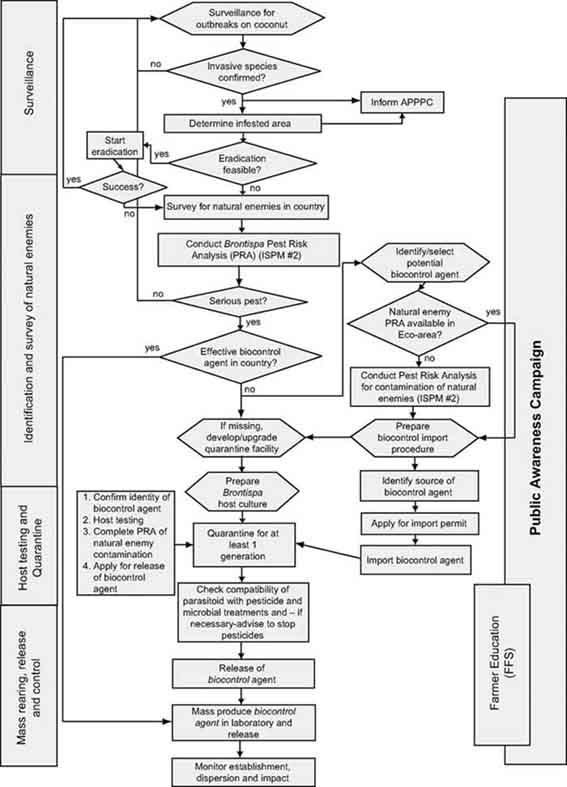
Figure 1: Flowchart for Brontispa classical biological control*
* For more details please refer to ISMP #3.
In this session, participants are invited to respond to the four questions posed by the facilitator and the answers are listed:
Q. Why does it take so long to initiate biological control for an introduced pest like Brontispa?
Answers:
1.Lack of information.
2.Lack of expertise/experience.
3.Importance of the pest not understood. 4.Infrastructure/capacity.
5.Over-emphasis of chemical control.
6.Governmental management systems of controlling and reporting invasive pests
7.Mindset for easy option (quick fix by use of chemical control).
8.Policy advocacy.
Q. Are national programmes sufficiently ready and capable to carry out classical biological control?
Answers:
1.Training of quarantine and plant protection as well as harmonizing knowledge.
2.Expert knowledge and practical experience.
3.Financial requirements for mass application. 4.Capacity building and facilities.
5.Specificity of biological control agent requires high level expertise
6.Sharing of experiences.
7.Strengthen quarantine. 8.Farmer Education.
9.Public awareness and publicity.
Q. What is the benefit of regional collaboration and regional programme in classical biological control of coconut pests?
Answers:
1.Speeds up the activity implementation.
2.Reduces costs and increases sustainability. 3.Optimizes resources.
4.Shares experiences/knowledge and avoids bad lessons/pitfalls.
5.Facilitates exchanges of biological agents.
6.Promotes understanding between countries.
Q. What would you recommend to strengthen and enhance the capacity to implement classical biological control?
Answers:
1.Database of crop pests and natural enemies (coconuts and other crops).
2.National project/programme setting.
3.Impact assessment as part of the programme. 4.Enhance the capacity of extension staff.
5.Advocacy/meetings.
6.Strengthening regulatory framework of pesticides.
Nguyen Thi Thuy Oanh, Nguyen Huu Truc, Le Cao Luong
Introduction
The hispine beetle, Brontispa longissima Gestro is spreading in many countries of Southeast Asia and the Pacific. Recently, it was recorded to have appeared in Viet Nam, Maldives, Singapore, China and Nauru.
Both larvae and adults feed on the leaves of coconut palms and other species of the family Palmae. The damage caused by the insect leads to leaf burn, yield loss and in many cases, plant death. According to scientific literature, this insect pest can be completely controlled at low cost by using natural enemies, especially parasitoids.
The project TCP/VIE/2905, funded by FAO, commenced in Viet Nam in February, 2003. In June, the parasitoid Asecodes hispinarum was imported from Samoa, subjected into quarantine and released in August, 2003. Field surveys confirmed that the parasitoid was established in many areas of Viet Nam. To help the parasitoid spread over the country, local parasitoid rearing and release is desirable. This document is designed to support training programmes for that purpose.
Biology of Brontispa
1.Adults lay one to five eggs per day and live up to 220 days during which they can lay 100 eggs. The adults hide from daylight and move slowly mostly at night time.

2.Eggs are laid in clusters of 1-5 eggs and hatch after five days.

3. Larvae chew leaf surfaces. There are four instar larval stages with a duration of 30 to 40 days. Larvae are less active.
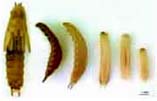
4. Brontispa normally chewes on un-opened leaves. The damaged leaves become dry.
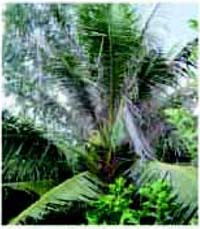
Mass-rearing Brontispa Since A. hispinarum is a specific parasitoid which only parasitizes its host - the hispine beetle should be mass-reared to provide a host for the parasitoid.
5. Preparing boxes for rearing: Plastic boxes of different sizes can be used. This picture shows plastic boxes with the dimension: 30 x 10 x 6 cm (L x W x H). The lid is cut and replaced by a piece of fine cloth fixed by glue for ventilation.

6.Leaflets of coconut spears are cut into small pieces of 5-7 cm length. Make sure that the leaf is not contaminated with any insecticides.
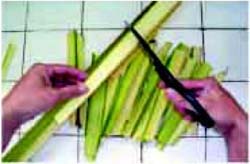
7.Place 50-60 female adult Brontispa into a box containing small pieces of leaf on which the females will lay eggs.

8.Prepare a new box with fresh leaves every two days and transfer the adult Brontispa into the new box. It is necessary to add some new adult Brontispa to replace dead ones.
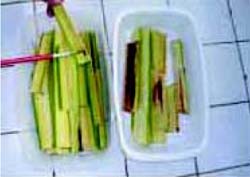
9.The eggs will hatch between four to five days after being laid. Transfer 100 larvae each in to a box with small pieces of leaf which are replaced every three to four days.
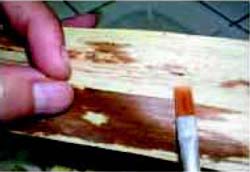
10. This picture shows how to transfer larvae into new boxes.

11.This picture shows how to transfer larvae into new boxes.
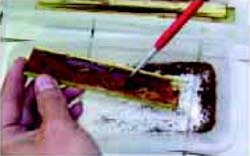
12.Keep pupae in boxes with 2-3 pieces of leaf which provide as food when pupae become adult.
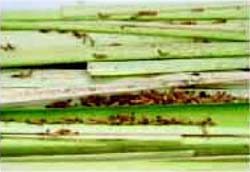
Mass-rearing parasitoid
Biology:
Life cycle: from egg to adult emergence: 18-20 days at 28°C.
Adult stage: females live for seven to ten days, while males live only two to three days; normally they die soon after mating.
Females attack 4th instar larvae of Brontispa.
Foods of adults: honey, honey dew, nectar.
13.The parasitoid can be reared in boxes or plastic or glass tubes.
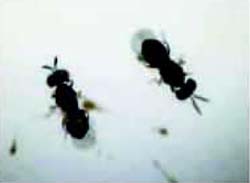
Rearing in plastic boxes
14.Size of box: 6x12 x 5 cm (W x L x H). The lid is removed and replaced by a fine cloth fixed by glue. In one side of box a hole of 0.5 cm diameter is made. The adult parasitoids will be introduced into the box through this hole.

15.Place five to seven small pieces of leaf and 10-20 larvae of the 4th instar per box. A piece of tissue paper soaked into honey solution (30 percent) is pasted on wall to provide food for adults.

16.Introduce about 100 adult parasitoids into the box by inserting a tube containing parasitoids into the hole.
After 24 hours, transfer the parasitoids into the new box.

17.The parasitized hosts become less active and turn brown in color after six days.

18.Parasitized hosts are then isolated individually in small vials (0.4 cm in dia., 7 cm long).
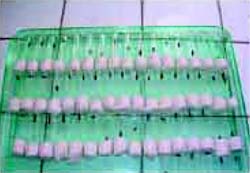
19.The parasitoid will emerge after 18-20 days of incubation.
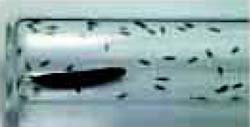
Rearing parasitoid in glass tubes
20.Glass tubes of 3 cm diameter and 13 cm length can be used.
Place 3-4 pieces of leaf in a tube and 10 larvae of Brontispa.

21.A piece of tissue paper soaked in honey solution (30 percent) is pasted on the wall of the tube.

22. Introduce parasitoids into the tube by inserting a vial containing newly emerged adults.
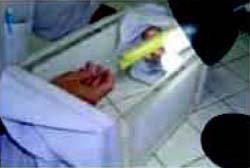
23.Fix the tube with a thick cloth.

After 24 hours, transfer the parasitoids into a new tube by connecting it with the old one which is covered by black paper. The parasitoids will move to the new tube as they are attracted by light.
The parasitized hosts are reared with the same procedure as above but in glass tube.
Releasing parasitoids
24.Releasing adult parasitoids:
Open the lid and the parasitoids will fly out after some minutes. It is better to release them in early morning or late afternoon. It is recommended to feed them well before releasing.
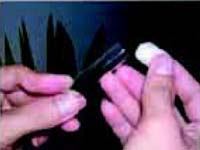
25.Releasing developing stages:
The parasitoids are placed inside a plastic box three days before adult emergence. Several holes are made in the walls of box to provide exit places for parasitoids.
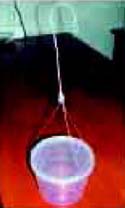
26.Hang the box on a tree which is close to coconut palms damaged by Brontispa.

Flow chart for mass-rearing Brontispa and parasitoid
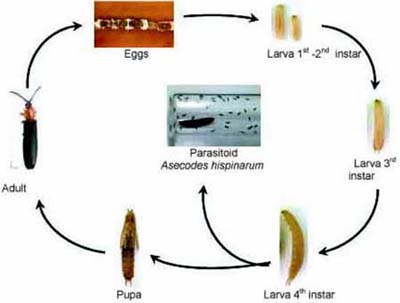
Acknowledgement
This work has been done with support from the FAO project TCP/VIE/2905 on "Integrated pest management of hispine beetle Brontispa longissima in Viet Nam".
References
CABI. 1998. CD software, Crop Protection Compendium. The Crop Protection Compendium is CAB International is encyclopedic, multimedia knowledge tool on all aspects of crops, crop pests, diseases, weeds, and biocontrol agents. Published by Centre for Agricultue and Biosciences International.
Cochereau P. 1969. Installation of Tetrastichus brontispa Ferriere. (Hymenoptera, Eulophidae) parasite of Brontispa longissima Gestro var. froggatti Sharp (Coleoptera, Chrysomelidae, Hispinae) in the peninsula of Noumea. Cahiers ORSTROM, Serie Biologie, 7:139-141.
FAO, 1981. The coconut hispine, Brontispa longissima. Quarterly Newsletter, FAO Plant Protection Committee for the South East Asia and Pacific Region, 24:9-10.
Franssen CJH, Mo TT. 1952. Biological control of the coconut pests in south Celebes. Landbouw, 24:319-360.
Hollingsworth R, Meleisea S, Iosefa T. 1988. Natural enemies of Brontispa longissima (Gestro) in West Samoa. Alafua Agricultural Bulletin, 13 (1):41-45, 7 ref.
Lever RJAW. 1936a. Control of Brontispa in Celebes by the parasite Tetrastichodes of Java. British Solomon Islands Protectorate Agricultural Gazette, 3:6.
Lever RJAW. 1936b. Brontispa leaf beetles and their parasite Tetrastichodes in the Austro-Malayan region. British Solomon Islands Protectorate Agricultural Gazette, 3:10-11.
O'Connor BA, 1940. Notes of the coconut leaf hispa, Brontispa froggatti Sharp and its parasites. New Guinea Agricultural Gazette, 6:36-40.
Stapley JH, 1971. The introduction and establishment of the Brontispa parasite in the Solomon Islands. South Pacific Commission Information Circular, 30:2-6.
Volgele JM, 1989. Biological control of Brontispa longissima in Western Samoa: an ecological and economic evaluation. Agriculture, Ecosystems and Environment, 27:315-329.
Volgele JM, Zeddies J, 1990. Economic analysis of classical biological pest control: a case study from Western Samoa. Deutsche Landwirtschafts-Gesellschaft, 1:45-51.
Secretariat of the International Plant Protection
Convention
Food and Agriculture Organization
of the United
Nations
Rome, 1996
Review and amendment
International standards for phytosanitary measures are subject to periodic review and amendment. The next review date for this standard is 2001, or such other date as may be agreed upon by the Commission on Phytosanitary Measures.
Standards will be updated and republished as necessary. Standard holders should ensure that the current edition of this standard is being used.
Distribution
International standards for phytosanitary measures are distributed by the Secretariat of the International Plant Protection Convention to all FAO Members, plus the Executive/Technical Secretariats of the Regional Plant Protection Organizations:
Asia and Pacific Plant Protection Commission
Caribbean Plant Protection Commission
Comité Regional de Sanidad Vegetal para el Cono Sur
Comunidad Andina
European and Mediterranean Plant Protection Organization
Inter-African Phytosanitary Council
North American Plant Protection Organization
Organismo Internacional Regional de Sanidad Agropecuaria
Pacific Plant Protection Organization.
Introduction
Scope
This standard describes the process of pest risk analysis for plant pests for the purpose of preparing phytosanitary regulations by National Plant Protection Organizations.
References
Glossary of phytosanitary terms, 1997. ISPM Pub. No. 5, FAO, Rome.*
International Plant Protection Convention, 1992. FAO, Rome.
Principles of plant quarantine as related to international trade, 1995. ISPM Pub. No. 1, FAO, Rome.
* The terms and definitions published in 1996 in this standard conform to this edition of the Glossary of phytosanitary terms.
Definitions and abbreviations
|
Area |
An officially defined country, part of a country or all or parts of several countries. |
|
|
|
|
Endangered area |
An area where ecological factors favour the establishment of a pest whose presence in the area will result in economically important loss. |
|
|
|
|
Entry (of a pest) |
Movement of a pest into an area where it is not yet present, or present but not widely distributed and being officially controlled. |
|
|
|
|
Entry potential |
Likelihood of the entry of a pest. |
|
|
|
|
Establishment |
Perpetuation, for the foreseeable future, of a pest within an area after entry. |
|
|
|
|
Establishment potential |
Likelihood of the establishment of a pest. |
|
|
|
|
Introduction |
Entry of a pest resulting in its establishment. |
|
|
|
|
Introduction potential |
Likelihood of the introduction of a pest. |
|
|
|
|
IPPC |
International Plant Protection Convention, as deposited in 1951 with FAO in Rome and as subsequently amended. |
|
|
|
|
National Plant Protection Organization (NPPO) |
Official service established by a government to discharge the functions specified by the IPPC. |
|
|
|
|
Official |
Established, authorized or performed by a National Plant Protection Organization. |
|
|
|
|
Pest |
Any species, strain or biotype of plant or animal or any pathogenic agent, injurious to plants or plant products. |
|
|
|
|
Pest free area |
An area in which a specific pest does not occur as demonstrated by scientific evidence and in which, where appropriate, this condition is being officially maintained. |
|
|
|
|
Pest risk analysis (PRA) |
Pest risk assessment and pest risk management. |
|
|
|
|
Pest risk assessment |
Determination of whether a pest is a quarantine pest and evaluation of its introduction potential. |
|
|
|
|
Pest risk management |
The decision-making process of reducing the risk of introduction of a quarantine pest. |
|
|
|
|
Phytosanitary measure |
Any legislation, regulation or official procedure having the purpose to prevent the introduction and/or spread of quarantine pests. |
|
|
|
|
Phytosanitary regulation |
Official rule to prevent the introduction and/or spread of quarantine pests, by regulating the production, movement or existence of commodities or other articles, or the normal activity of persons, and by establishing schemes for phytosanitary certification. |
|
|
|
|
PRA area |
Area in relation to which a pest risk analysis is conducted. |
|
|
|
|
Quarantine pest |
A pest of potential economic importance to the area endangered thereby and not yet present there, or present but not widely distributed and being officially controlled. |
|
|
|
|
Spread |
Expansion of the geographical distribution of a pest within an area. |
|
|
|
|
Spread potential |
Likelihood of the spread of a pest. |
Outline of requirements
Pest risk analysis (PRA) consists of three stages: initiating the process for analyzing risk, assessing pest risk, and managing pest risk (see Figures 1-3).
Initiating the process involves identification of pests or pathways for which the PRA is needed. Pest risk assessment determines whether each pest identified as such, or associated with a pathway, is a quarantine pest, characterized in terms of likelihood of entry, establishment, spread and economic importance. Pest risk management involves developing, evaluating, comparing and selecting options for reducing the risk.
PRA is only meaningful in relation to a defined "PRA area" considered to be at risk. This is usually a country, but can also be an area within a country, or an area covering all or parts of several countries (e.g. the area covered by a Regional Plant Protection Organization [RPPO]).
General requirements for pest risk analysis (PRA)
1. Stage 1: Initiating the PRA process
There are generally two initiation points for a pest risk analysis (see Figure 1):
the identification of a pathway, usually an imported commodity, that may allow the introduction and/or spread of quarantine pests
the identification of a pest that may qualify as a quarantine pest.
Either can involve pests already present in the PRA area but not widely distributed and being officially controlled, as well as pests absent from the PRA area, since both are covered by the quarantine pest definition.
Stage 1: Initiation
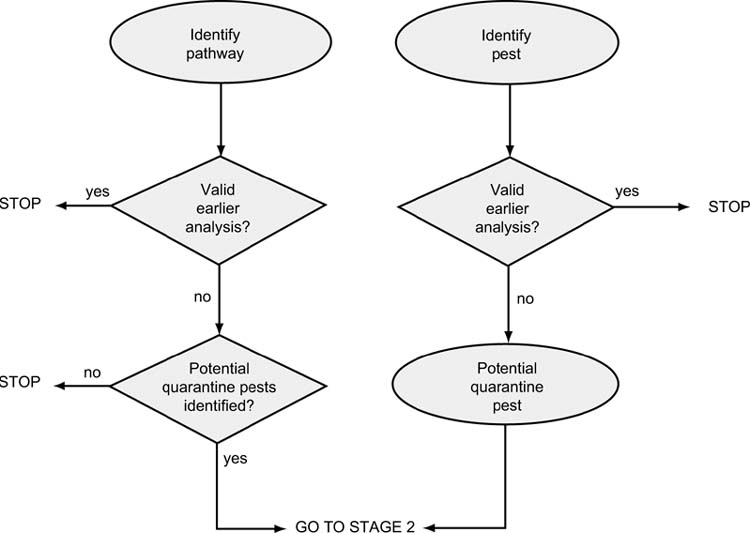
Figure 1: Pest risk analysis
1.1 PRA initiated by a pathway
A requirement for a new or revised PRA originating from a specific pathway will most frequently arise in the following situations:
International trade is initiated in a new commodity (usually a plant or plant product) or a commodity from a new origin. The PRA may be triggered by a request for import, or by the appearance in trade of consignments of a commodity. The pathway may concern a single area of origin or several.
New plant species are imported for selection and scientific research purposes
A pathway other than commodity import is identified (natural spread, mail, garbage, passenger's baggage etc.)
A policy decision is taken to establish or revise phytosanitary regulations or requirements concerning specific commodities
A new treatment, system or process, or new information impacts on an earlier decision.
The pests which are likely to follow the pathway (e.g. be carried by the commodity) are then listed, and each is then subjected to Stage 2 in the PRA process.[4] If no potential quarantine pests are identified as likely to follow the pathway, the PRA stops at this point.
1.2 PRA initiated by a pest
A requirement for a new or revised PRA originating from a specific pest will most frequently arise in the following situations:
An emergency arises on discovery of an established infestation or an outbreak of a new pest within a PRA area
An emergency arises on interception of a new pest on an imported commodity
A new pest risk is identified by scientific research
A pest is introduced into a new area other than the PRA area
A pest is reported to be more damaging in a new area other than the PRA area itself, than in its area of origin
Audits reveal that a particular pest is repeatedly intercepted
A request is made to import, as such, an organism, for example by researchers, educators, biological practitioners, businesses (pet store owners), the food industry (snails for consumption) or hobbyists (aquatic plants for aquaria)
A policy decision is taken to revise phytosanitary regulations or requirements concerning specific pests
A proposal is made by another country or by an international organization (RPPO, FAO)
A new treatment system, process, or new information impacts on an earlier decision.
The specific pest identified is then subjected to Stage 2 in the PRA process.
1.3 Review of earlier PRAs
Prior to proceeding with a new PRA, a check should be made as to whether the pathway or pest has already been subjected to the PRA process, either nationally or internationally. If a PRA exists, its validity should be checked as circumstances may have changed. The possibility of using a PRA from a similar pathway or pest, that may partly or entirely replace the need for this PRA, should also be investigated.
1.4 Conclusion for Stage 1
At the end of Stage 1, pests have been identified as potential quarantine pests, individually or in association with a pathway.
2. Stage 2: Pest risk assessment
Stage 1 has identified a pest, or list of pests (in the case of initiation by a pathway), to be subjected to risk assessment. Stage 2 considers these pests individually (see Figure 2). It examines, for each, whether the criteria for quarantine pest status are satisfied:
"a pest of potential economic importance to the area endangered thereby and not yet present there, or present but not widely distributed and being officially controlled."
In this context, "area" should be understood to mean:
"an officially defined country, part of a country, or all or part of several countries,"
and "endangered area" should be understood to mean:
"an area where ecological factors favour the establishment of a pest whose presence in the area will result in economically important loss."
In doing so, the PRA considers all aspects of each pest and in particular actual information about its geographical distribution, biology and economic importance. Expert judgement is then used to assess the establishment, spread and economic importance potential in the PRA area. Finally, the potential for introduction into the PRA area is characterized.
Stage 2: Assessment
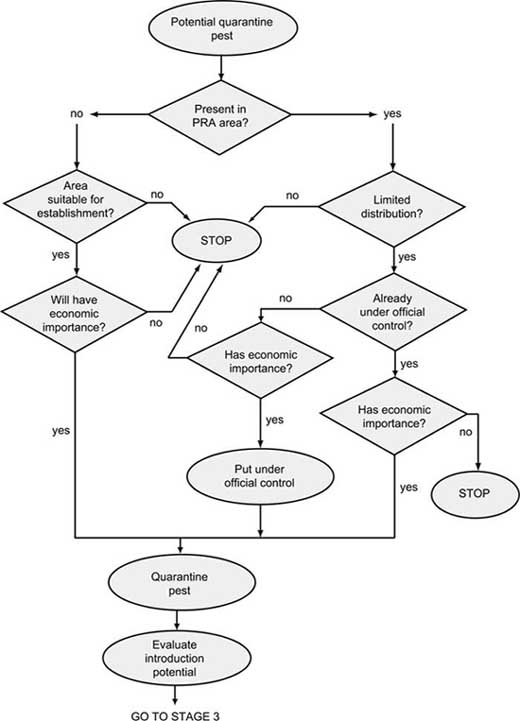
Figure 2: Pest risk analysis
In characterizing the risk, the amount of information available will vary with each pest and the sophistication of the assessment will vary with available tools. For example, one country may have elaborate pest databases and geographical information systems, another may depend on books, printed soil maps, and climate maps. In some cases, virtually no information may be available, or research may be needed to obtain it. Assessments will be limited by the amount of information available on the biology of a particular pest. Countries where the pest is present may provide available information for the country conducting the PRA, on request.
2.1 Geographical and regulatory criteria
For each pest subjected to the PRA process, the geographical and regulatory criteria in the quarantine pest definition should be considered:
If the pest is present in the PRA area and has reached the limits of its ecological range (i.e. is widely distributed), then the pest does not satisfy the definition of a quarantine pest and the PRA for the pest stops at this point
If the pest is present in the PRA area and has not reached the limits of its ecological range (i.e. not widely distributed), and the pest is subject to official control in the PRA area, then the pest satisfies this aspect of the definition of a quarantine pest
If the pest is not widely distributed but is under consideration of future official control in the PRA area, then the PRA will determine whether the pest should be placed under official control. If the conclusion is reached that the pest should be subject to official control, then the pest satisfies this aspect of the definition of the definition of a quarantine pest
If the pest is not widely distributed but is not subject to official control or consideration of future official control in the PRA area, then the pest does not satisfy the definition of a quarantine pest and the PRA for the pest stops at this point
If the pest is absent from the PRA area, then it satisfies this aspect of the definition of a quarantine pest.
2.2 Economic importance iriteria
For potential economic importance to be expressed, a pest must become established and spread. Thus the risk of a pest, having entered, becoming established and spreading in the PRA area must be characterized. The factors to be considered are set out below.[5]
2.2.1 Establishment potential
In order to estimate the establishment potential of a pest, reliable biological information (life cycle, host range, epidemiology, survival etc.) should be obtained from the areas where the pest currently occurs.
The situation in the PRA area can then be carefully compared with that in the areas where it currently occurs and expert judgement used to assess the establishment potential. Case histories concerning comparable pests can usefully be considered. Examples of the factors to consider are:
availability, quantity and distribution of hosts in the PRA area
environmental suitability in the PRA area
potential for adaptation of the pest
reproductive strategy of the pest
method of pest survival.
If a pest has no potential for establishment in the PRA area, then it does not satisfy the definition of a quarantine pest and the PRA for the pest stops at this point.
2.2.2 Spread potential after establishment
In order to estimate spread potential of the pest, reliable, biological information should be obtained from areas where the pest currently occurs.
The situation in the PRA area can then be carefully compared with that in the areas where the pest currently occurs and expert judgement used to assess the spread potential. Case histories concerning comparable pests can usefully be considered. Examples of the factors to consider are:
suitability of the natural and/or managed environment for natural spread of the pest
movement with commodities or conveyances
intended use of the commodity
potential vectors of the pest in the PRA area
potential natural enemies of the pest in the PRA area.
The information on spread potential is used to estimate how rapidly a pest's potential economic importance may be expressed within the PRA area. This also has significance if the pest is liable to enter and establish in an area of low potential economic importance and then spread to an area of high potential economic importance. In addition it may be important in the risk management stage (see Figure 3) when considering the ease with which an introduced pest could be contained or eradicated.
2.2.3 Potential economic importance
The next step in the PRA process is to determine whether the pest is of potential economic importance in the PRA area.
In order to estimate the potential economic importance of the pest, information should be obtained from areas where the pest currently occurs. For each of these areas, note whether the pest causes major, minor or no damage. Note whether the pest causes damage frequently or infrequently. Relate this, if possible, to biotic and abiotic effects, particularly climate.
The situation in the PRA area can then be carefully compared with that in the areas where the pest currently occurs. Case histories concerning comparable pests can usefully be considered. Expert judgement is then used to assess the potential for economic importance. Examples of the factors to consider are:
type of damage
crop losses
loss of export markets
increases in control costs
effects on on-going integrated pest management (IPM) programmes
environmental damage
capacity to act as a vector for other pests
perceived social costs such as unemployment.
Stage 3: Management from Stage 2
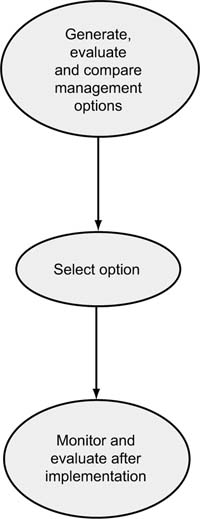
Figure 3: Pest risk analysis
If a pest has no potential economic importance in the PRA area, then it does not satisfy the definition of a quarantine pest and the PRA for the pest stops at this point.
2.3 Introduction potential
The final stage of assessment concerns the introduction potential which depends on the pathways from the exporting country to the destination, and the frequency and quantity of pests associated with them. Documented pathways for the pest to enter new areas should be noted. Potential pathways which may not currently exist should be assessed if known.
The following is a partial checklist that may be used to estimate the introduction potential divided into those factors which may affect the likelihood of entry and those factors which may affect the likelihood of establishment.
Entry:
opportunity for contamination of commodities or conveyances by the pest
survival of the pest under the environmental conditions of transport
ease or difficulty of detecting the pest at entry inspection
frequency and quantity of pest movement into the PRA area by natural means
frequency and number of persons entering from another country at any given port of entry.
Establishment:
number and frequency of consignments of the commodity
number of individuals of a given pest associated with the means of conveyance
intended use of the commodity
environmental conditions and availability of hosts at the destination and during transport in the PRA area.
2.4 Conclusion for Stage 2
If the pest satisfies the definition of a quarantine pest, expert judgement should be used to review the information collected during Stage 2 to decide whether the pest has sufficient economic importance and introduction potential,
i.e. sufficient risk, for phytosanitary measures to be justified. If so, proceed to Stage 3; if not, the PRA for the pest stops at this point.[6]
3. Stage 3: Pest risk management
Pest risk management (see Figure 3) to protect the endangered areas should be proportional to the risk identified in the pest risk assessment. In most respects it can be based on the information gathered in the pest risk assessment. Phytosanitary measures should be applied to the minimum area necessary for the effective protection of the endangered area.
3.1 Risk management options
A list of options for reducing risks to an acceptable level should be assembled. These options will primarily concern pathways and in particular the conditions for permitting entry of commodities. Examples of the options to consider are:
inclusion in list of prohibited pests
phytosanitary inspection and certification prior to export
definition of requirements to be satisfied before export (e.g. treatment, origin from pest free area, growing season inspection, certification scheme)
inspection at entry
treatment at point of entry, inspection station or, if appropriate, at place of destination
detention in post-entry quarantine
post-entry measures (restrictions on use of commodity, control measures)
prohibition of entry of specific commodities from specific origins.
They may also, however, concern ways of reducing the risk of damage, for example, introduction of a biological control agent, or ease of eradication or containment.
3.2 Efficacy and impact of the options
The efficacy and impact of the various options in reducing risk to an acceptable level should be evaluated, in terms of the following factors:
biological effectiveness
cost/benefit of implementation
impact on existing regulations
commercial impact
social impact
phytosanitary policy considerations
time to implement a new regulation
efficacy of option against other quarantine pests
environmental impact.
The positive and negative aspects of the options should be specified. While it is recognized that countries according to the sovereignty principle may exercise their sovereign right to utilize phytosanitary measures, countries should also take particular note of the "Minimal impact" principle:
Phytosanitary measures shall be consistent with the pest risk involved, and shall represent the least restrictive measures available which result in the minimum impediment to the international movement of people, commodities and conveyances.
Article VI.2(f) of the International Plant Protection Convention makes a similar but less comprehensive provision. Phytosanitary measures recommended should be based on all of the above factors.
In order to determine which options are appropriate, it may be advisable to communicate with interested and affected groups within and outside the PRA area.
3.3 Conclusion for Stage 3
At the end of Stage 3, the appropriate phytosanitary measures concerning the pest or pathway have been decided. Completion of Stage 3 is essential; it is in particular not justified to complete only Stages 1 and 2 and then take phytosanitary measures without proper assessment of risk management options. After implementation of the phytosanitary measures, their effectiveness should be monitored and the risk management options should be reviewed, if necessary.
4. Documenting the PRA process
A PRA should be sufficiently documented so that when a review or a dispute arises, the PRA will clearly state the sources of information and the rationales used in reaching a management decision regarding phytosanitary measures taken or to be taken.
For further information on international standards, guidelines and recommendations concerning phytosanitary measures, and the complete list of current publications, please contact the:
Secretariat of the International Plant Protection Convention
|
By mail: |
IPPC Secretariat |
|
Fax: |
+ (39) (06) 57056347 |
|
E-mail: |
Or visit our Website at:
http://www.fao.org/WAICENT/FaoInfo/Agricult/AGP/AGPP/PQ/Default.htm
Secretariat of the International Plant Protection
Convention
Food and Agriculture Organization
of the United
Nations
Rome, 1996
Review and amendment
International standards for phytosanitary measures are subject to periodic review and amendment. The next review date for this standard is 2001, or such other date as may be agreed upon by the Commission on Phytosanitary Measures.
Standards will be updated and republished as necessary. Standard holders should ensure that the current edition of this standard is being used.
Distribution
International standards for phytosanitary measures are distributed by the Secretariat of the International Plant Protection Convention to all FAO Members, plus the Executive/Technical Secretariats of the Regional Plant Protection Organizations:
Asia and Pacific Plant Protection Commission
Caribbean Plant Protection Commission
Comité Regional de Sanidad Vegetal para el Cono Sur
Comunidad Andina
European and Mediterranean Plant Protection Organization
InterAfrican Phytosanitary Council
North American Plant Protection Organization
Organismo Internacional Regional de Sanidad Agropecuaria
Pacific Plant Protection Organization.
Introduction
Scope
This standard describes the Code of Conduct for the Import and Release of Exotic Biological Control Agents. It lists the responsibilities of the authorities of governments, and the responsibilities of the exporters and importers of biological control agents.
The Code addresses the importation of exotic biological control agents capable of self-replication (parasitoids, predators, parasites, phytophagous arthropods and pathogens) for research and/or release into the environment including those packaged or formulated as commercial products.
Governments that are already fulfilling the objectives of this Code by regulation or other equivalent means may consider adapting their existing systems in the light of this Code.
References
Anon, 1988. New organisms in New Zealand. Procedures and legislation for the importation of new organisms into New Zealand and the development, field testing and release of genetically modified organisms. A discussion document.
Ministry for the Environment, Wellington, New Zealand, 59 p.
Coulson, J.R. & Soper, R.S., 1989. Protocols for the introduction of biological control agents in the U.S. pp. 1-35. In Plant Protection and Quarantine Vol. III, Special Topics. R.P. Kahn (ed.), CRC Press, Boca Raton, Florida.
Coulson, J.R., Soper, R.S. & Williams, D.W., 1992. Proceedings of USDA ARS Workshop on Biological Control Quarantine: Needs and Procedures, 14-17 Jan. 1991, Baltimore, Maryland, Washington, DC, US Department of Agriculture, Agricultural Research Service, 336 p.
EEC, 1991. Official Journal of the European Communities: Council Directive of 15 July 1991.
Glossary of phytosanitary terms, 1997. ISPM Pub. No. 5, FAO, Rome.[7]
Guidelines for pest risk analysis, 1996. ISPM Pub. No. 2, FAO, Rome.
Guidelines on the registration of biological pest control agents, 1988. FAO, Rome.
International code of conduct on the distribution and use of pesticides (Amended version), 1990. FAO, Rome.
International Plant Protection Convention, 1992. FAO, Rome.
Laird, M., Lacey, L.A. & Davidson, E.W. (eds.), 1990. Safety of microbial insecticides. CRC Press, Boca Raton, Florida, 259 p.
Leppla, N.C. & Ashley, T.R. 1978. Facilities for insect research and production. USDA Technical Bulletin, No. 1576, 86 p.
Lundholm, B. & Stackerud, M. (eds.), 1980. Environmental protection and biological forms of control of pest organisms. Swedish Natural Science Research Council, Ecological Bulletin No. 31, 171 p.
NORAGRIC, 1990. Proceedings of the workshop on health and environmental impact of alternative control agents for desert locust control. NORAGRIC Occasional Papers Series C. Development and Environment, No. 5, 114 p.
Waterhouse, D.F., 1991. Guidelines for biological control projects in the Pacific. South Pacific Commission Information Document, 57, Noumea, New Caledonia, 30 p.
WHO, 1981. Mammalian safety of microbial agents for vector control: a WHO memorandum. Bulletin of the World Health Organization, 59:857-863.
Definitions and abbreviations
|
Antagonist |
An organism (usually pathogen) which does no significant damage to the host but its colonization of the host protects the host from significant subsequent damage by a pest. |
|
|
|
|
Area |
An officially defined country, part of a country or all or parts of several countries. |
|
|
|
|
Authority |
The National Plant Protection Organization, or other entity or person officially designated by the government to deal with matters arising from the responsibilities set forth in the Code. |
|
|
|
|
Biological control (Biocontrol) |
Pest control strategy making use of living natural enemies, antagonists or competitors and other self-replicating biotic entities. |
|
|
|
|
Biological control agent |
A natural enemy, antagonist or competitor, and other self-replicating biotic entity, used for pest control. |
|
|
|
|
Biological pesticide (Biopesticide) |
A generic term, not specifically definable, but generally applied to a biological control agent, usually a pathogen, formulated and applied in a manner similar to a chemical pesticide, and normally used for the rapid reduction of a pest population for short-term pest control. |
|
|
|
|
Classical biological control |
The intentional introduction and permanent establishment of an exotic biological agent for long-term pest control. |
|
|
|
|
Competitor |
An organism which competes with pests for essential elements (e.g. food, shelter) in the environment. |
|
|
|
|
Ecoarea |
An area with similar fauna, flora and climate and hence similar concerns about the introduction of biological control agents. |
|
|
|
|
Ecosystem |
A complex of organisms and their environment, interacting as a defined ecological unit (natural or modified by human activity,e.g. agroecosystem), irrespective of political boundaries. |
|
|
|
|
Establishment (of a biological control agent) |
The perpetuation, for the foreseeable future, of a biological control agent within an area after entry. |
|
|
|
|
Exotic |
Not native to a particular country, ecosystem or ecoarea (applied to organisms intentionally or accidentally introduced as a result of human activities). As this Code is directed at the introduction of biological control agents from one country to another, the term"exotic" is used for organisms not native to a country. |
|
|
|
|
Import permit (of a biological control agent) |
An official document authorizing importation (of a biological control agent) in accordance with specified requirements. |
|
|
|
|
Introduction (of a biological control agent) |
The release of a biological control agent into an ecosystem where it did not exist previously (see also"establishment"). |
|
|
|
|
Inundative release |
The release of overwhelming numbers of a mass- produced, invertebrate biological control agent in the expectation of achieving a rapid reduction of a pest population without necessarily achieving continuing impact. |
|
|
|
|
IPPC |
International Plant Protection Convention, as deposited in 1951 with FAO in Rome and as subsequently amended. |
|
|
|
|
Legislation |
Any act, law, regulation, guideline or other administrative order promulgated by a government. |
|
Micro-organism |
A protozoan, fungus, bacterium, virus or other microscopic self-replicating biotic entity. |
|
|
|
|
National Plant Protection Organization (NPPO) |
Official service established by a government to discharge the functions specified by the IPPC. |
|
|
|
|
Natural enemy |
An organism which lives at the expense of another organism and which may help to limit the population of its host. This includes parasitoids, parasites, predators and pathogens. |
|
|
|
|
Naturally occurring |
A component of an ecosystem or a selection from a wild population, not altered by artificial means. |
|
|
|
|
Organism |
Biotic entity capable of reproduction or replication; vertebrate or invertebrate animals, plants and micro-organisms. |
|
|
|
|
Parasite |
An organism which lives on or in a larger organism, feeding upon it. |
|
|
|
|
Parasitoid |
An insect parasitic only in its immature stages, killing its host in the process of its development, and free living as an adult. |
|
|
|
|
Pathogen |
Micro-organism causing disease. |
|
|
|
|
Pest |
Any species, strain or biotype of plant, animal, or pathogenic agent, injurious to plants or plant products. |
|
|
|
|
Predator |
A natural enemy that preys and feeds on other animal organisms, more than one of which are killed during its lifetime. |
|
|
|
|
Quarantine (of a biological control agent) |
Official confinement of biological control agents subject to phytosanitary regulations for observation and research, or for further inspection and/or testing. |
|
|
|
|
Release (into the environment) |
Intentional liberation of an organism into the environment (see also "introduction" and "establishment"). |
|
|
|
|
Specificity |
A measure of the host range of a biological control agent on a scale ranging from an extreme specialist only able to complete development on a single species or strain of its host (monophagous) to a generalist with many hosts ranging over several groups of organisms (polyphagous). |
Outline of the code
The Code is concerned with the importation of exotic biological control agents capable of self-replication (e.g. parasitoids, predators, parasites, phytophagous arthropods and pathogens) for research, and field release of control agents used in biological control and those used as biological pesticides. Currently used formulations of live pathogens are included because they possess the potential for multiplication and persistence in the environment. Naturally occurring strains (genetically, if not morphologically distinct entities) of natural enemies may show notable differences in specificity and infectivity, for example strains of Bacillus thuringiensis (Bt), and if exotic, fall within the terms of reference of this Code.
It is recognized that it may often be difficult to know whether the agent in a biological pesticide is exotic or not. For that reason many biological pesticides may have to be treated as though they were exotic.
The Code does not deal with other pest control techniques, that are also sometimes referred to as "biological controls", notably, autocidal methods, resistant host plants, as well as behaviour-modifying chemicals and other novel biological products. For toxic products of microbes used as pesticides which cannot reproduce and which are similar to conventional chemical pesticides, refer to the FAO International Code of Conduct on the Distribution and Use of Pesticides where they are covered in detail.
Procedures governing the handling and release into the environment of strains of organisms created artificially by genetic engineering are currently being examined by various international organizations and by national programmes. If required this Code could be applied to these organisms.
It is possible that this Code, after due evaluation, could also be applied to the introduction of exotic biological agents to control pests affecting human or animal health or the conservation of natural habitats.
Thus the Code deals with:
the import of exotic biological control agents for research,
the import and release of exotic biological control agents for biocontrol,
the import and release of exotic biological control agents for use as biological pesticides where those products incorporate organisms which can multiply.
It does this by:
identifying the three main groups involved in importing and releasing biological control agents: authorities (as the organizations representing government); exporters and importers;
describing three responsibility phases of the process of import and release: the responsibilities of those involved before export; those before and upon importation; and those after importation.
Code of Conduct for the import and release of exotic biological control agents
1. Objectives of the Code
1.1 The objectives of the Code are to:
facilitate the safe import, export and release of exotic biological control agents by introducing procedures of an internationally acceptable level for all public and private entities involved, particularly where national legislation to regulate their use does not exist or is inadequate;
describe the shared responsibility of the many segments of society involved and the need for cooperation between importing and exporting countries so that:
- benefits to be derived are achieved without significant adverse effects,
- practices which ensure efficient and safe use while minimizing health and environmental concerns due to improper handling or use are promoted.
Standards are described that:
encourage responsible and generally accepted trade practices,
assist countries to design regulations to control the suitability and quality of imported exotic biological control agents and to address the safe handling, assessment and use of such products;
promote the safe use of biological control agents for the improvement of agriculture, and human, animal and plant health;
allow all those involved in the import or release of exotic biological control agents to determine if, in the context of the International Plant Protection Convention and other relevant conventions and legislation, their proposed actions and the actions of others constitute acceptable practices.
1.2 Responsibilities are outlined for the entities which are addressed by this Code, including governments, individually or in regional groupings; international organizations; research institutes; industry, including producers, trade associations, and distributors; users; and public-sector organizations such as environmental groups, consumer groups and trade unions. All references in this Code to a government or governments shall be deemed to apply equally to regional groupings of governments for matters falling within their areas of competence.
2. Designation of authority responsible
2.1 Governments should designate the competent authority empowered (normally the National Plant Protection Organization) to regulate or otherwise control and, where appropriate, issue permits for the importation and release of biological control agents. The authority may exercise its powers by using an internationally accepted standard (such as this Code) for guidance or by applying national legislation (which should be aligned with this Code). Importations of biological control agents should only be carried out with the consent of the authority.
2.2 The authority needs to:
2.2.1 Consider the legislation and regulations for the import and release of biological control agents.
2.2.2 Establish procedures for the assessment of the dossiers specified in section 4 and for establishing conditions appropriate to the assessed risk for the importation of biological control agents either with confinement in quarantine or directly to the importing agent without such requirement.
2.2.3 Maintain appropriate communication with and advise affected parties, including, where appropriate, other authorities on:
despatch and handling procedures,
release and evaluation of agents,
distribution, trade and advertising factors,
labelling, packaging and storage,
information exchange, and
occurrence of unexpected and/or deleterious incidents, including remedial action taken.
3. Responsibilities of authorities prior to import
3.1 The authority of an importing country should:
3.1.1 Endeavour to promote compliance with the Code or use specific powers or introduce necessary legislation to regulate the import, distribution and release of biological control agents in their countries, and make provision for effective enforcement.
3.1.2 Evaluate the dossiers specified in section 4 on the pest and the candidate biocontrol agent supplied by the importer in relation to the degree of acceptable risk and establish conditions for importation, containment or release appropriate to the assessed risk.
3.1.3 Issue regulations and/or import permits stating conditions to be fulfilled by the exporter and importer. As appropriate, these should include the:
requirements to ensure authoritative identification of the agent,
specified source of the biocontrol agent,
precautions to be taken against inclusion of natural enemies of the agent,
measures required for the exclusion of contaminants (especially quarantine pests),
nature of the packaging to provide appropriate security,
measures to allow inspection without escape of contents,
point of entry,
person or organization to receive the consignment,
conditions under which the package may be opened,
facilities in which the biological control agent may be held.
3.1.4 Ensure that procedures are available for the full documentation of the importation (identity, origins), release (numbers/quantities, dates, localities), impact of each particular biological control agent in each country and any other data relevant to assessing the outcome, and make records are available to the scientific community and the public, as may be appropriate, while protecting any proprietary rights to the data.
3.1.5 If appropriate, ensure entry and where required, processing through quarantine facilities or consider where a country does not have secure quarantine facilities, the importation through an accredited intermediate quarantine station in a third country.
3.1.6 Ensure the deposition in appropriate collections of authoritatively identified voucher specimens of the pest(s) and imported biological control agent where they will be available for reference and study.
3.1.7 Consider the necessity to require culturing of imported control agents in quarantine before release. Culturing for one generation can help in ensuring purity of the culture, authoritative identification, freedom from hyperparasites and pathogens or associated pests. This is especially advisable when wild collected agents are involved.
3.1.8 Decide if after a first import, further imports of the same biological control agent can be exempted from some or all of the requirements for import.
3.1.9 Maintain appropriate communication with and advise affected parties, including, where appropriate, other authorities on:
despatch and handling procedures,
release and evaluation of agents,
distribution, trade and advertising factors,
labelling, packaging and storage,
information exchange, and
occurrence of unexpected and/or deleterious incidents, including remedial action to be taken.
3.1.10 Ensure, in the case of repeat imports of a biological control agent for use in biocontrol or as a biopesticide, that documentation of the certification system permitting entry and release is such that only imports of at least equivalent standard to the approved import are released.
3.1.11 Take action to inform and educate local suppliers of biological control agents, farmers, farmer organizations, agricultural workers' unions, and other interested parties on the appropriate use of biological control agents.
3.1.12 Consult with authorities in neighbouring countries within the same ecoarea and with relevant regional organizations to clarify and resolve any potential conflicts of interest that may arise between countries.
3.2 The authority of an exporting country, to the extent possible, should:
3.2.1 Ensure that regulations of the importing country relevant to the Code are followed in the export from their countries of biological control agents.
3.2.2 Follow, where the importing country has no or limited legislation concerning the import of biological control agents, the elements of the Code concerning the export of agents.
3.2.3 Ensure that arrangements are made for the taking and storing of voucher specimens of the exported material.
4. Responsibilities of importer prior to import
4.1 At the first importation, the importer of biological control agents for any purpose should prepare dossiers for submission to the authority with information on the pest to be controlled, including:
4.1.1 Accurate identification of the target pest, its world distribution and probable origin,
4.1.2 Assessment of its importance,
4.1.3 Its known natural enemies, antagonists or competitors already present or used in the proposed release area or in other parts of the world.
4.2 At the first importation, the importer of biological control agents for any purpose should prepare dossiers with information on the candidate biological control agent including:
4.2.1 Accurate identification or, where necessary, sufficient characterization of the agent to allow its unambiguous recognition,
4.2.2 A summary of all available information on its origin, distribution, biology, natural enemies and impact in its area of distribution,
4.2.3 An analysis of the host specificity of the biological control agent and any potential hazards posed to non-target hosts,
4.2.4 Natural enemies or contaminants of the candidate agent and procedures required for their elimination from laboratory colonies including, if appropriate, procedures to accurately identify and, if necessary, eliminate from the culture the host upon which the agent was cultured.
4.3 At the first importation, the importer of biological control agents for any purpose should also prepare a dossier for presentation to the authority which identifies potential hazards analyses the risks posed thereby and proposes mitigating procedures with respect to:
those who may be handling biological control agents under laboratory, production and field conditions,
human and animal health following introduction.
4.4 The importer of candidate biological control agents proposed for research in quarantine only should include information on the above points, plus the:
nature of the material proposed for importation,
security of quarantine (based on a description of the facilities and the qualifications of the staff).
4.5 The importer of biological control agents for import and release and use as biological pesticides should include in the dossier specified in 4.3 above, an analysis of the risks posed to possible non-target organisms and to the environment generally and should detail available emergency procedures should the biological control agent after release display unexpected adverse properties.
The dossier should also contain a report detailing laboratory tests, and/or field observations and any other appropriate data to indicate the known or probable host range of the candidate agent. Testing should be based on recommended procedures and approved by the authority. These tests should relate to the candidate agent only and different procedures should apply to any additives used in formulations of products which contain biological control agents.
5. Responsibilities of exporter prior to export
5.1 Exporters of biological pesticides and other biological control agents for inundative release should:
5.1.1 Take all necessary steps to ensure that exported biological control agents conform to relevant regulations of importing countries, FAO and World Health Organization specifications concerning labelling, packaging and advertising, in particular the International Code of Conduct on Distribution and Use of Pesticides, as applicable, and this Code.
5.1.2 Ensure that biological control agents used in biological pesticides and for inundative release are evaluated for safety as provided for in section 4.3.
5.1.3 Ensure that all biological pesticides and other biological control agents for inundative release are evaluated for safety to human health and the environment and freedom from contaminating organisms.
5.2 The exporter of biological control agents for any purpose should ensure that:
5.2.1 All conditions specified in the regulations of the importing country or on the import permit are complied with.
5.2.2 Consignments, upon export, are accompanied by appropriate documentation:
specifying that the contents are in compliance with the legislative provisions of the importing country and the permit provisions for that consignment,
including information on the identity and recognition, safety, rearing or culture, and handling methods of the agent, and on possible contaminants, their recognition and elimination.
5.2.3 Packaging be sufficiently robust and consists of inert material secured in such a way that it can be inspected without escape of the contents. Wherever possible, organisms should be transported without their hosts (to reduce quarantine risks) and/or when they are in a dormant, inactive stage that is least likely to escape from packaging.
5.3 The exporter of biological control agents for research or classical biological control should also ensure that:
5.3.1 The import permit and all other documentation required in association with it are available prior to dispatch of the agent.
5.3.2 Packages are properly labelled in the official language of the importing country as to their contents and handling both in transit and on receipt in the receiving country. The information should include instructions to handlers and officials at the point of entry on how the package should be treated to avoid damage to the contents and on action to be taken if the packaging is breached. It should also indicate whether it may be opened for customs inspection or must be sent directly into quarantine before opening.
5.3.3 Advance notice with full details of routing is provided to the receiver to minimize delays and to alert officials at the point of entry.
6. Responsibilities of authorities upon import
6.1 Authorities should:
6.1.1 Ensure that, where required (see section 3.1.5), all imports of classical biological control agents for research or biological control, after completion of import requirements at the point of entry, are taken directly to the specified quarantine facility for inspection or other required procedure. All dead, diseased or contaminated material, as well as extraneous material and packaging material should be sterilized or destroyed in quarantine.
6.1.2 Ensure that biological control agents for which it is considered necessary (see section 3.1.6) are cultured in quarantine as long as has been specified by the authority.
6.1.3 Allow certain biological control agents to be passed directly for release providing all conditions have been complied with and appropriate documentary evidence is made available (see section 3). In all cases where identification or compliance is to be checked, this should be undertaken in a secure laboratory (i.e. a closed room with facilities for sterilizing or autoclaving extraneous or suspect materials).
7. Responsibilities of authorities before and upon release
7.1 Authorities should:
7.1.1 If not already agreed under the terms of the import permit: Consider for approval for release following critical assessment of the submitted dossier on the agent and the establishment of appropriate conditions to reduce the assessed risk to an acceptable level. Assessments should be made using the types of procedures established in the ISPM Guidelines for pest risk analysis (e.g. to assess risks to non-target organisms and to identify risk-mitigating procedures). This may require information from specified additional tests.
7.1.2 Ensure full documentation of novel importations and their release programme as to identities, origins, numbers/quantity released, localities, dates, location of voucher specimens and any other data relevant to assessing the outcome, and maintenance of records of appropriate information with regard to other repeated releases of the same species.
7.1.3 Encourage the monitoring of the release of biological control agents in order to assess the impact on the target and non-target organisms.
7.1.4 Where problems (i.e. unexpected deleterious incidents) are identified, consider, and where appropriate, ensure corrective action is taken and inform all relevant interested parties.
8. Responsibilities of importer after import and release
8.1 The importer should:
8.1.1 Ensure that persons involved in distribution of their biological control agents are trained adequately, such that they are capable of providing a user with advice on efficient use.
8.1.2 Make information relating to the safety and environmental impact of biological control agents publicly available, and maintain a free and frank exchange of information, not subject to commercial confidentiality, with exporters, authorities other importers and operators of programmes involving biocontrol agents.
8.1.3 Consider publication of the results of each first importation and release programme in an international journal. Such publication should include details of the programme and its economic and environmental impact as soon as practicable after the release of the agent.
8.1.4 Notify the authorities when problems occur and voluntarily take corrective action and, when requested by authorities, help to find solutions to difficulties.
8.1.5 Ensure application of the provisions of Article 11 of the International Code of Conduct on the Distribution and Use of Pesticides with respect to the advertising of commercial preparations of biological control agents for sale to the public.
9. Observance of the Code
9.1 This Code should be observed through collaborative action on the part of: governments, individually or in regional groupings; international organizations; research institutes; industry, including producers, trade associations, and distributors; users; and other organizations such as environmental groups, consumer groups and trade unions.
9.2 The Code should be interpreted so that the requirements of other relevant codes or treaties are respected.
9.3 All parties addressed by this Code should observe this Code and promote the principles and ethics expressed, irrespective of other parties' ability to observe the Code.
9.4 The parties involved in providing biological control agents should retain an active interest in following their products, keeping up to date with major users and with the occurrence of problems arising in the use of their products.
9.5 FAO Members should periodically review the relevance and effectiveness of the Code. The Code should be considered a dynamic text which must be brought up to date as required, taking into account technical, economic and social progress.
9.6 Authorities should monitor the observance of the Code and report on progress made to the Director-General of FAO.
For further information on international standards, guidelines and recommendations concerning phytosanitary measures, and the complete list of current publications, please contact the:
Secretariat of the International Plant Protection Convention
|
By mail: |
IPPC Secretariat |
|
Fax: |
+ (39) (06) 57056347 |
|
E-mail: |
Or visit our Website at:
http://www.fao.org/WAICENT/FaoInfo/Agricult/AGP/AGPP/PQ/Default.htm
|
[2] International Standards for
Phytosanitary Measures - Guidelines for pest risk analysis Publication No. 2,
February 1996 FAO, Rome. 19 pp. [3] International Standards for Phytosanitary Measures - Code of conduct for the import and release of exotic biological control agents Publication No. 3, February 1996 FAO, Rome. 19 pp. [4] The list of pests may be generated by any combination of databases, literature sources, or expert consultation. Once the list of pests has been established, it is preferable to prioritize it by using expert judgement before the next step. According to the results obtained, it may or may not be necessary to conduct a risk assessment on all pests on the list. [5] Fuller checklists of information which can usefully be considered in assessing the potential for establishment, spread and economic importance, are available from national and international sources. [6] Decision-making schemes, or expert systems, may be useful at this stage to assist expert judgement. [7] The terms and definitions published in 1996 in this standard conform to this edition of the Glossary of phytosanitary terms. |